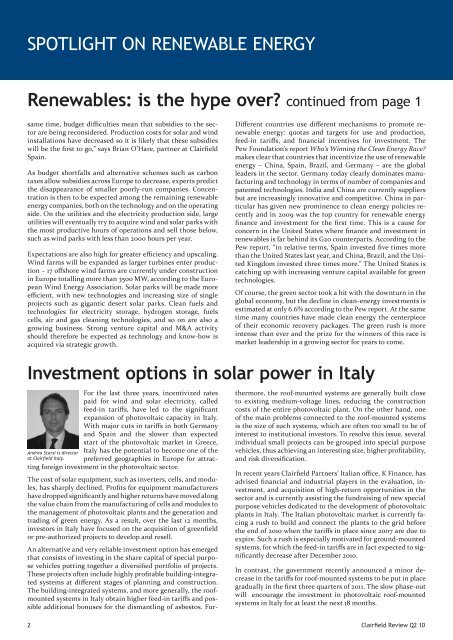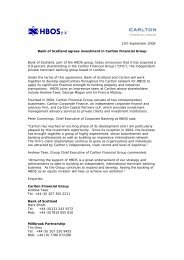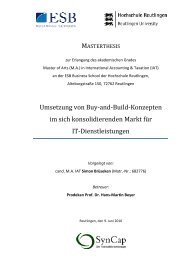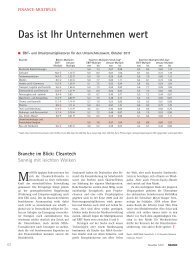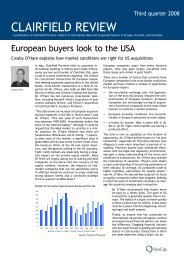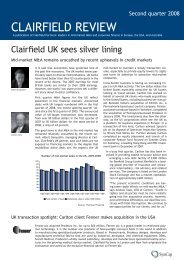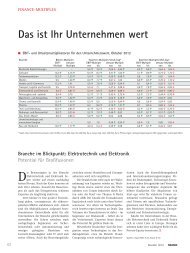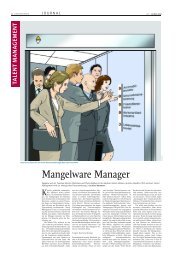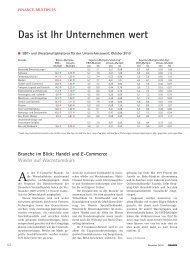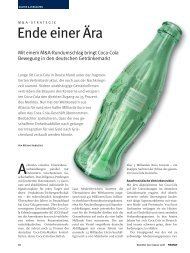is the hype over? - Syncap
is the hype over? - Syncap
is the hype over? - Syncap
You also want an ePaper? Increase the reach of your titles
YUMPU automatically turns print PDFs into web optimized ePapers that Google loves.
SPOTLIGHT ON RENEWABLE ENERGY<br />
Renewables: <strong>is</strong> <strong>the</strong> <strong>hype</strong> <strong>over</strong>? continued from page 1<br />
same time, budget difficulties mean that subsidies to <strong>the</strong> sector<br />
are being reconsidered. Production costs for solar and wind<br />
installations have decreased so it <strong>is</strong> likely that <strong>the</strong>se subsidies<br />
will be <strong>the</strong> first to go,” says Brian O’Hare, partner at Clairfield<br />
Spain.<br />
As budget shortfalls and alternative schemes such as carbon<br />
taxes allow subsidies across Europe to decrease, experts predict<br />
<strong>the</strong> d<strong>is</strong>appearance of smaller poorly-run companies. Concentration<br />
<strong>is</strong> <strong>the</strong>n to be expected among <strong>the</strong> remaining renewable<br />
energy companies, both on <strong>the</strong> technology and on <strong>the</strong> operating<br />
side. On <strong>the</strong> utilities and <strong>the</strong> electricity production side, large<br />
utilities will eventually try to acquire wind and solar parks with<br />
<strong>the</strong> most productive hours of operations and sell those below,<br />
such as wind parks with less than 2000 hours per year.<br />
Expectations are also high for greater efficiency and upscaling.<br />
Wind farms will be expanded as larger turbines enter production<br />
– 17 offshore wind farms are currently under construction<br />
in Europe totalling more than 3500 MW, according to <strong>the</strong> European<br />
Wind Energy Association. Solar parks will be made more<br />
efficient, with new technologies and increasing size of single<br />
projects such as gigantic desert solar parks. Clean fuels and<br />
technologies for electricity storage, hydrogen storage, fuels<br />
cells, air and gas cleaning technologies, and so on are also a<br />
growing business. Strong venture capital and M&A activity<br />
should <strong>the</strong>refore be expected as technology and know-how <strong>is</strong><br />
acquired via strategic growth.<br />
Different countries use different mechan<strong>is</strong>ms to promote renewable<br />
energy: quotas and targets for use and production,<br />
feed-in tariffs, and financial incentives for investment. The<br />
Pew Foundation’s report Who’s Winning <strong>the</strong> Clean Energy Race?<br />
makes clear that countries that incentivize <strong>the</strong> use of renewable<br />
energy – China, Spain, Brazil, and Germany – are <strong>the</strong> global<br />
leaders in <strong>the</strong> sector. Germany today clearly dominates manufacturing<br />
and technology in terms of number of companies and<br />
patented technologies. India and China are currently suppliers<br />
but are increasingly innovative and competitive. China in particular<br />
has given new prominence to clean energy policies recently<br />
and in 2009 was <strong>the</strong> top country for renewable energy<br />
finance and investment for <strong>the</strong> first time. Th<strong>is</strong> <strong>is</strong> a cause for<br />
concern in <strong>the</strong> United States where finance and investment in<br />
renewables <strong>is</strong> far behind its G20 counterparts. According to <strong>the</strong><br />
Pew report, “in relative terms, Spain invested five times more<br />
than <strong>the</strong> United States last year, and China, Brazil, and <strong>the</strong> United<br />
Kingdom invested three times more.” The United States <strong>is</strong><br />
catching up with increasing venture capital available for green<br />
technologies.<br />
Of course, <strong>the</strong> green sector took a hit with <strong>the</strong> downturn in <strong>the</strong><br />
global economy, but <strong>the</strong> decline in clean-energy investments <strong>is</strong><br />
estimated at only 6.6% according to <strong>the</strong> Pew report. At <strong>the</strong> same<br />
time many countries have made clean energy <strong>the</strong> centerpiece<br />
of <strong>the</strong>ir economic rec<strong>over</strong>y packages. The green rush <strong>is</strong> more<br />
intense than ever and <strong>the</strong> prize for <strong>the</strong> winners of th<strong>is</strong> race <strong>is</strong><br />
market leadership in a growing sector for years to come.<br />
Investment options in solar power in Italy<br />
Andrea Scarsi <strong>is</strong> director<br />
at Clairfield Italy.<br />
For <strong>the</strong> last three years, incentivized rates<br />
paid for wind and solar electricity, called<br />
feed-in tariffs, have led to <strong>the</strong> significant<br />
expansion of photovoltaic capacity in Italy.<br />
With major cuts in tariffs in both Germany<br />
and Spain and <strong>the</strong> slower than expected<br />
start of <strong>the</strong> photovoltaic market in Greece,<br />
Italy has <strong>the</strong> potential to become one of <strong>the</strong><br />
preferred geographies in Europe for attrac-<br />
ting foreign investment in <strong>the</strong> photovoltaic sector.<br />
The cost of solar equipment, such as inverters, cells, and modules,<br />
has sharply declined. Profits for equipment manufacturers<br />
have dropped significantly and higher returns have moved along<br />
<strong>the</strong> value chain from <strong>the</strong> manufacturing of cells and modules to<br />
<strong>the</strong> management of photovoltaic plants and <strong>the</strong> generation and<br />
trading of green energy. As a result, <strong>over</strong> <strong>the</strong> last 12 months,<br />
investors in Italy have focused on <strong>the</strong> acqu<strong>is</strong>ition of greenfield<br />
or pre-authorized projects to develop and resell.<br />
An alternative and very reliable investment option has emerged<br />
that cons<strong>is</strong>ts of investing in <strong>the</strong> share capital of special purpose<br />
vehicles putting toge<strong>the</strong>r a diversified portfolio of projects.<br />
These projects often include highly profitable building-integrated<br />
systems at different stages of planning and construction.<br />
The building-integrated systems, and more generally, <strong>the</strong> roofmounted<br />
systems in Italy obtain higher feed-in tariffs and possible<br />
additional bonuses for <strong>the</strong> d<strong>is</strong>mantling of asbestos. Fur-<br />
<strong>the</strong>rmore, <strong>the</strong> roof-mounted systems are generally built close<br />
to ex<strong>is</strong>ting medium-voltage lines, reducing <strong>the</strong> construction<br />
costs of <strong>the</strong> entire photovoltaic plant. On <strong>the</strong> o<strong>the</strong>r hand, one<br />
of <strong>the</strong> main problems connected to <strong>the</strong> roof-mounted systems<br />
<strong>is</strong> <strong>the</strong> size of such systems, which are often too small to be of<br />
interest to institutional investors. To resolve th<strong>is</strong> <strong>is</strong>sue, several<br />
individual small projects can be grouped into special purpose<br />
vehicles, thus achieving an interesting size, higher profitability,<br />
and r<strong>is</strong>k diversification.<br />
In recent years Clairfield Partners’ Italian office, K Finance, has<br />
adv<strong>is</strong>ed financial and industrial players in <strong>the</strong> evaluation, investment,<br />
and acqu<strong>is</strong>ition of high-return opportunities in <strong>the</strong><br />
sector and <strong>is</strong> currently ass<strong>is</strong>ting <strong>the</strong> fundra<strong>is</strong>ing of new special<br />
purpose vehicles dedicated to <strong>the</strong> development of photovoltaic<br />
plants in Italy. The Italian photovoltaic market <strong>is</strong> currently facing<br />
a rush to build and connect <strong>the</strong> plants to <strong>the</strong> grid before<br />
<strong>the</strong> end of 2010 when <strong>the</strong> tariffs in place since 2007 are due to<br />
expire. Such a rush <strong>is</strong> especially motivated for ground-mounted<br />
systems, for which <strong>the</strong> feed-in tariffs are in fact expected to significantly<br />
decrease after December 2010.<br />
In contrast, <strong>the</strong> g<strong>over</strong>nment recently announced a minor decrease<br />
in <strong>the</strong> tariffs for roof-mounted systems to be put in place<br />
gradually in <strong>the</strong> first three quarters of 2011. The slow phase-out<br />
will encourage <strong>the</strong> investment in photovoltaic roof-mounted<br />
systems in Italy for at least <strong>the</strong> next 18 months.<br />
2 Clairfield Review Q2 10


